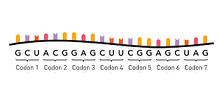Before entering fully into the definition of the term genetic code, it is necessary to know the etymological origin of the two words that give it shape:
-Code is a word that derives from the Latin "codicus", which in turn emanates from "codex", which were the books that were used to write the rules.
-Genetic, on the other hand, is a term that etymologically derives from Greek. In his case, it emanates from "genetikos" and means "that originates."
The concept of code has several uses. In this case we are interested in staying with its meaning as the combination of characters that, within the framework of a certain system, has a certain value.
 Genetics , for its part, is that linked to biological inheritance and genes: the deoxyribonucleic acid ( DNA ) sequence that acts as a functional unit in the transfer of those characteristics that are inherited.
Genetics , for its part, is that linked to biological inheritance and genes: the deoxyribonucleic acid ( DNA ) sequence that acts as a functional unit in the transfer of those characteristics that are inherited.
From these definitions, we can understand what the notion of genetic code refers to. This is the name given to the key to the data contained in genes, which indicates the universal correspondence that exists between the sequence of nucleic acids and the sequence of proteins . The genetic code, in this way, details how hereditary characteristics are transmitted .
The rules established by the genetic code allow the translation of a sequence of nucleotides (a compound formed by a nitrogenous base, phosphoric acid and a sugar ) to a sequence of amino acids present in a protein . In this way, it specifies the link between sequences of three nucleotides (which are called codons ) and three amino acids. Each codon corresponds to a specific amino acid.
Codons, therefore, are sequences of three nucleotides that, in the so-called messenger RNA , are responsible for encoding the addition of a certain amino acid in the biosynthesis of proteins. The relationship between codons and amino acids is established by the genetic code.
In RNA , the sequence of the genetic material involves adenine ( A ), uracil ( U ), guanine ( G ) and cytokine ( C ), while in DNA the participating nitrogenous bases are adenine ( A ). , thymine ( T ), guanine ( G ) and cytokine ( C ). These letters that form the codons are those that appear in the genetic code. A codon sequence establishes the characteristics of a sequence of amino acids in each protein.
Other data of interest about the genetic code are the following:
-The aforementioned code, as a general rule, is represented in a table where the amino acid that is encoded by each codon is identified.
-It has the peculiarity that there can be more than one codon coding for more than one amino acid. This is what is known as synonymous codons.
-The number of codons is 64: 61 that code for amino acids and 3 that do not code but act as "stop signals."
-We can also highlight the fact that the genetic code does not present any type of imperfection and also does not have overlaps.
-There are numerous important figures throughout history who have worked on the genetic code. However, unquestionably the most relevant or those who have left a most relevant legacy are Severo Ochoa, Har Gobind Khorana, Marshall W. Nirenberg and Sydney Brenner as well as Francis Crick, among many others.
